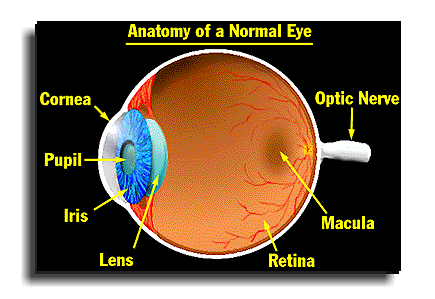
What is Macular Degeneration?
Macular degeneration is a disease common in older individuals, characterized by deterioration in the central part of the retina called the macula. It is the leading cause of vision loss, affecting more than 10 million Americans - more than cataracts and glaucoma combined. At present, Macular Degeneration is considered an incurable eye disease.
Macular Degeneration is caused by the deterioration of the central portion of the retina, the inside back layer of the eye that records the images we see and sends them via the optic nerve from the eye to the brain. The retina’s central portion, known as the macula, is responsible for focusing central vision in the eye, and it controls our ability to read, drive a car, recognize faces or colors, and see objects in fine detail. A healthy macula is necessary to be able to read fine print or recognize faces at a distance.
Are there Different Types of Macular Degeneration?
Macular degeneration comes in many forms with different rates of progression and severity. Commonly, the disease is broken down into two groups known as “dry” and “wet.” Dry macular degeneration is characterized by small yellow deposits in the macula, called drusen, as well as areas of atrophy. This form is typically slowly progressive with many patients maintaining functional vision for many years. There are no current medical treatments for dry macular degeneration. Wet macular degeneration occurs when abnormal blood vessels grow into the macula causing bleeding, swelling, and scarring. Another form of of macular degeneration is Stargardt disease found in young people. It is caused by a recessive gene.
Risk Factors
The biggest risk factor for Macular Degeneration is age. Your risk increases as you age, and the disease is most likely to occur in those 55 and older. Other risk factors include:
Treatment
There is currently no known cure for Macular Degeneration, but there are things you can do to reduce your risk and possibly slow the progression once you’ve been diagnosed. For example, one can pursue lifestyle changes like dieting, exercise, avoiding smoking, and protecting your eyes from ultraviolet light. In addition, there have been many recent advancements in halting the progression of wet macular degeneration using lasers, injectable medications and vitamin supplements.
Living with Macular Degeneration
People with macular degeneration should follow the directions of their eye doctor. And even patients with significant impairment can often continue to read by being fitted with special vision aides. Some of these devices are simple magnifiers while others are more complicated camera and projection systems.
Macular degeneration is a disease common in older individuals, characterized by deterioration in the central part of the retina called the macula. It is the leading cause of vision loss, affecting more than 10 million Americans - more than cataracts and glaucoma combined. At present, Macular Degeneration is considered an incurable eye disease.
Macular Degeneration is caused by the deterioration of the central portion of the retina, the inside back layer of the eye that records the images we see and sends them via the optic nerve from the eye to the brain. The retina’s central portion, known as the macula, is responsible for focusing central vision in the eye, and it controls our ability to read, drive a car, recognize faces or colors, and see objects in fine detail. A healthy macula is necessary to be able to read fine print or recognize faces at a distance.
Are there Different Types of Macular Degeneration?
Macular degeneration comes in many forms with different rates of progression and severity. Commonly, the disease is broken down into two groups known as “dry” and “wet.” Dry macular degeneration is characterized by small yellow deposits in the macula, called drusen, as well as areas of atrophy. This form is typically slowly progressive with many patients maintaining functional vision for many years. There are no current medical treatments for dry macular degeneration. Wet macular degeneration occurs when abnormal blood vessels grow into the macula causing bleeding, swelling, and scarring. Another form of of macular degeneration is Stargardt disease found in young people. It is caused by a recessive gene.
Risk Factors
The biggest risk factor for Macular Degeneration is age. Your risk increases as you age, and the disease is most likely to occur in those 55 and older. Other risk factors include:
- Genetics - People with a family history of macular degeneration are at a higher risk.
- Race - Caucasians are more likely to develop the disease than African-Americans or Hispanics/Latinos.
- Smoking - Smoking doubles the risk of macular degeneration.
Treatment
There is currently no known cure for Macular Degeneration, but there are things you can do to reduce your risk and possibly slow the progression once you’ve been diagnosed. For example, one can pursue lifestyle changes like dieting, exercise, avoiding smoking, and protecting your eyes from ultraviolet light. In addition, there have been many recent advancements in halting the progression of wet macular degeneration using lasers, injectable medications and vitamin supplements.
Living with Macular Degeneration
People with macular degeneration should follow the directions of their eye doctor. And even patients with significant impairment can often continue to read by being fitted with special vision aides. Some of these devices are simple magnifiers while others are more complicated camera and projection systems.


